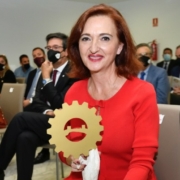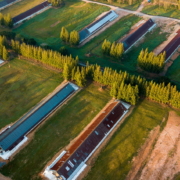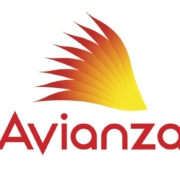AVIANZA PARTICIPA EN LA CREACIÓN DE LA RED MUNICIPAL GANADERO-CÁRNICA
El tejido municipal de España ha jugado un papel crucial en el desarrollo de la cadena ganadero-cárnica. Sus tierras han servido para alimentar y criar a los animales, sus vecinos han trabajado con esfuerzo en el proceso desde la granja a la mesa de los consumidores, y los ayuntamientos han dado las facilidades necesarias para que estas iniciativas prosperen. Este trabajo institucional y ciudadano, unido al de las empresas del sector, ha permitido que la cadena ganadero-cárnica sea, desde hace varias décadas, el principal motor económico y agente vertebrador de la España Rural.
En este sentido, como agradecimiento al constante apoyo brindado, las seis organizaciones interprofesionales de la carne (ASICI, Avianza, Intercun, Interovic, Interporc y Provacuno), han lanzado la “Red municipal ganadero-cárnica”, una plataforma que pretende rendir homenaje a todos esos municipios de España en los que la carne se ha convertido en un sello de identidad propio. Con este gesto, las interprofesionales cárnicas quieren devolver el afecto recibido a lo largo de los años por el conjunto de los ciudadanos y corporaciones municipales y poner en valor su aportación al desarrollo del sector cárnico y a la economía en general.
Además de rendir este homenaje, la “Red municipal ganadero-cárnica” nace con la vocación de convertirse en una plataforma de diálogo entre el sector privado y el público a nivel municipal, por lo que la Red aspira a fortalecer las alianzas con aquellos municipios con actividad ganadero-cárnica que quieran contribuir al reconocimiento de la cadena como palanca de desarrollo. La red será representativa de la diversidad social, geográfica, política y cultural de nuestro país.
Cómo formar parte de la Red
Las organizaciones interprofesionales están actualmente en contacto con decenas de ayuntamientos por toda la geografía española, con el fin de que se integren, proceso que ya ha comenzado y que se concretará en las próximas semanas. No obstante, cualquier municipio donde el sector ganadero-cárnico tenga actividad puede formar parte de la red, a través de la aprobación de una declaración institucional del pleno de los ayuntamientos. Los municipios interesados encontrarán toda la información necesaria en la página web redganaderocarnica.es.
Desarrollo de las zonas rurales
La “Red municipal ganadero-cárnica” buscará poner en valor la relación simbiótica existente entre este sector socio-económico y los ayuntamientos de las regiones en que opera. Hay que tener en cuenta que la actividad ganadero-cárnica juega una papel fundamental a la hora de fijar población en muchas localidades, reduciendo así la brecha territorial del país y el progresivo proceso de despoblación de zonas rurales. La gran diversidad ganadera que existe y las propias condiciones de la cadena, que facilita que mucha población se establezca cerca de las granjas y negocios, ha permitido que las zonas con presencia ganadero-cárnica resistan mucho mejor el desafío, en muchos casos hasta revertir el proceso.
La variedad de especies y formas ganaderas también permite conservar y aprovechar muchos de los paisajes de la España Rural. Las zonas de montaña acogen una buena parte del vacuno, los terrenos improductivos y de alto interés ecológico son pastoreados por el ganado ovino y caprino, el porcino ibérico forma parte del paisaje de la dehesa, las granjas cunícolas se asientan en núcleos de menos de 2.000 habitantes y el porcino de capa blanca representa a uno de los sectores de mayor rentabilidad económica en localidades de menos de 5.000 habitantes.
El sector agroalimentario, y el subsector cárnico en particular, también es una oportunidad para desarrollar iniciativas industriales asociadas en estas zonas donde se genera empleo y se diversifica la actividad económica. En el caso de la industria cárnica, que es la rama líder dentro de la alimentación en España, la actividad industrial está conformada por 2.750 empresas entre las que abundan las de pequeño y mediano tamaño. Estas empresas se localizan preferentemente en zonas rurales con las mismas dificultades de territorio sobre el que se asienta la ganadería.
Generador de oportunidades
La cadena ganadero-cárnica aportó 42.000 millones de euros al PIB nacional en 2019, (15.172,6 millones de producción ganadera y 26.822 millones de euros de la industria cárnica), lo que representa el 22,6% de todo el sector alimentario. El subsector cárnico-ganadero alcanzó en 2019 el 28,8% de la Producción Final Agraria y el 77,4% de la Producción Final generada por todo el sector animal según el MAPA.
En lo que respecta al empleo, las granjas ganaderas, la industria cárnica y todo el sistema de distribución y venta generan 672.000 empleos directos. El total se reparte entre el medio millón de personas dedicadas a la ganadería, los 97.000 trabajadores de las industrias cárnicas y las 75.000 personas empleadas en el comercio minorista. En total se calcula que unos dos millones de personas viven de la cadena ganadero-cárnica en nuestro país, incluyendo la producción agrícola para el ganado, y los sectores de los profesionales veterinarios, piensos, sanidad animal, logística y transporte e industrias auxiliares.
En cuanto a las exportaciones, el volumen en 2019 alcanzó los 7.555 millones de euros, lo que equivale a toda la industria de madera y corcho española, con un crecimiento del 26% en facturación exterior y un 15,1% en volumen con respecto a las cifras del año anterior. Estas cifras tienen una especial relevancia estratégica en un momento donde el comercio internacional está sufriendo un fuerte retroceso y donde la cadena ganadero-cárnica se ha erigido como una garantía para mantener el balance positivo de la balanza de pagos.
El comercio de carnes tiene un fuerte componente anticíclico y resiliente, pues en el mes de abril de 2020, en pleno confinamiento, mientras que la tasa de variación interanual de nuestras exportaciones para todos los sectores económicos caía el 39,3%, el de las carnes aumentó el 13% por un valor de 635 millones de euros.









